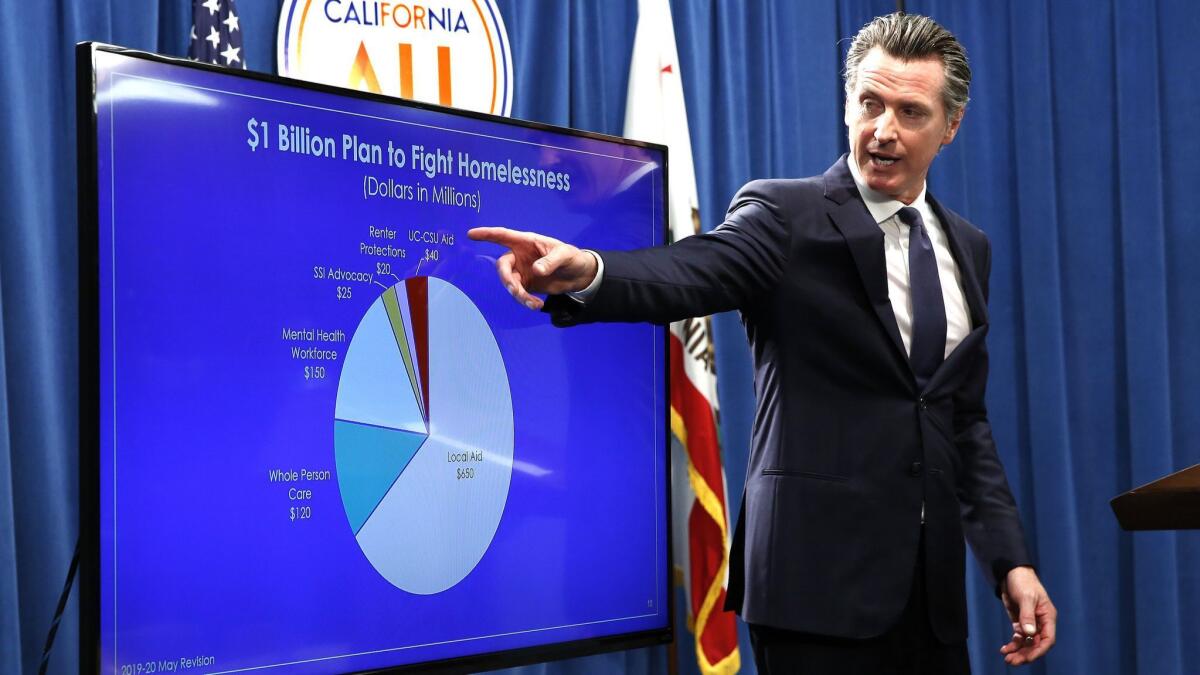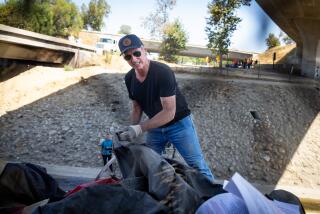Newsom is promising a database to track homeless people statewide. It wonât be that easy

âBecause you canât manage what you donât measure,â Gov. Gavin Newsom said in his State of the State address last week that California âwill establish a unified homelessness data system to capture accurate, local information.â
He made it sound so simple and matter-of-fact. But for those homeless advocates who have long struggled to compile such data, Newsom was evoking a quest like that for the Holy Grail â a prize that is difficult to reach, but which everyone wants.
âThatâs awesome,â said Miguel Santana when asked to consider whether a statewide database should exist. But the former Los Angeles administrative officer who spent years involved in the cityâs homelessness planning wasnât sure that it could.
The governorâs plan will only work, he said, if âevery jurisdiction, every county, every city, is asked to aggregate data across the board thatâs similarâ â and that would be a project of immense complexity.
Instead, one state agency is attempting a more attainable goal of collecting data on homeless people from Californiaâs 44 so-called continuums of care. But thatâs no simple task either.
These continuums of care are local agencies established to administer federal homelessness programs under the U.S. Department of Housing and Urban Development. There are four in Los Angeles County alone. The cities of Long Beach, Pasadena and Glendale each have one, and the Los Angeles Homeless Services Authority, or LAHSA, covers the remainder of the county.
Each maintains its own database, or Homeless Management Information System, which tracks every person who comes into contact with the system of government agencies and nonprofits that work with homeless people. The information entered into each database by outreach workers and case managers must adhere to general federal guidelines, but also can vary from place to place.
The challenge is consistency.
âThe first step is to clean up the data, make sure itâs accurate. Secondly, is it usable?â said Sarah Dusseault, chairwoman of the commission that oversees LAHSA. âYou donât want a system where, in Los Angeles we think âmatched to housingâ means this and yet in San Bernardino it means something else.â
With consistent data, California could, for the first time, track where homeless people live and move around the state, and identify those who are using housing and services in more than one place. That would make the process of getting people off the streets more efficient.
Finding a way to achieve that is a job that rests with the California Homeless Coordinating and Finance Council, an agency created in 2017 to oversee the stateâs homelessness policies.
Even before Newsomâs speech, the agency was preparing a contract that it hopes to award this fall to pull information from the stateâs 44 continuums of care, said Lynn von Koch-Liebert, deputy secretary of the California Business, Consumer Services and Housing Agency.
Whichever company receives the contract will set up an automated system to collect the data more frequently and for every homeless person, with names and other identifying information removed for privacy. Currently, that information is only collected annually by the federal government.
Californiaâs new system tentatively could be in place by the end of the year.
âOne of the goals would be to see if individuals are exiting homelessness in a successful way or if they are moving between different types of housing,â Koch-Liebert said. âIf they are leaving homelessness, we will be able to see those patterns.â
The next phase will be more ambitious, attempting to similarly compile data from more sources, such as county health departments across the state.
LAHSA has just started building such a data system for Los Angeles County. And it has been a challenge.
In addition to LAHSA, more than a dozen local and regional agencies provide services and maintain their own data systems. Some keep records on people. Some keep records on housing that has been provided. Some do both.
As a result, a homeless person who has been entered into LAHSAâs Homeless Management Information System might also be in a database run by the Department of Health Services or the Housing Authority for the city of L.A. â with different information in each database.
âThey understand data differently because theyâve been programmed differently,â Dusseault said.
LAHSA has been working with the staff of those other local and regional agencies to build a complete data profile of each homeless personâs contact with every agency. The goal is to find out whatâs working smoothly and whatâs not.
An initiative along the lines of what Newsom has suggested to expand that across the state would be welcome, Dusseault said, if itâs done right.
âWeâd want to make sure we had the help both to improve our system locally,â she said, âbut [also] to make sure that other systems throughout the state are all at that same level of accuracy and usefulness, so that we can talk to each other in a way that gets better outcomes.â
More to Read
Sign up for Essential California
The most important California stories and recommendations in your inbox every morning.
You may occasionally receive promotional content from the Los Angeles Times.







